New First Anchor in Cassidy Arch Canyon, Capitol Reef National Park
The Coalition of American Canyoneers was asked by Capitol Reef National Park to consult on anchors in Cassidy Arch Canyon. This canyon has seen a tremendous increase in canyoneering activity over the past couple of years. The traditional first anchor was off of a tree above the arch on canyon left. The tree is showing signs of wear and tear and there are numerous rope grooves on the rock, either from rappelling or pulling the rope. In order to mitigate this damage, canyoneers were asked to use a retrievable anchor off of the tree.
Recently compliance with this request has been less than 100%, continuing to damage the rock and leaving a sling on the tree much of the time.
On June 6th, CAC members Dean Brooks and Tom Jones visited the site with Capitol Reef Canyoneering Lead Ranger Josh Olsen and prepared recommendations to the Park. Consequently, Capitol Reef NP requested that a permanent bolt anchor be installed. The new anchor is just downstream of the tree on canyon left (LDC), about 20 feet towards the arch. As always, anchors of all types must be thoroughly inspected each time before use. Webbing may need to be replaced. Periodically bolts may need to be replaced; placing and replacing bolts in Capitol Reef NP requires a permit from the Park.
Additionally, several problematic anchors have been identified downcanyon – either causing rope groove damage or relying on stressed vegetation. The Park has approved replacement fixed anchors to address these issues. Installation work will proceed throughout the summer in anticipation of the fall canyon season. Until then, rappels can be made off the current anchors.
Please use the new anchor. Do not use the tree.
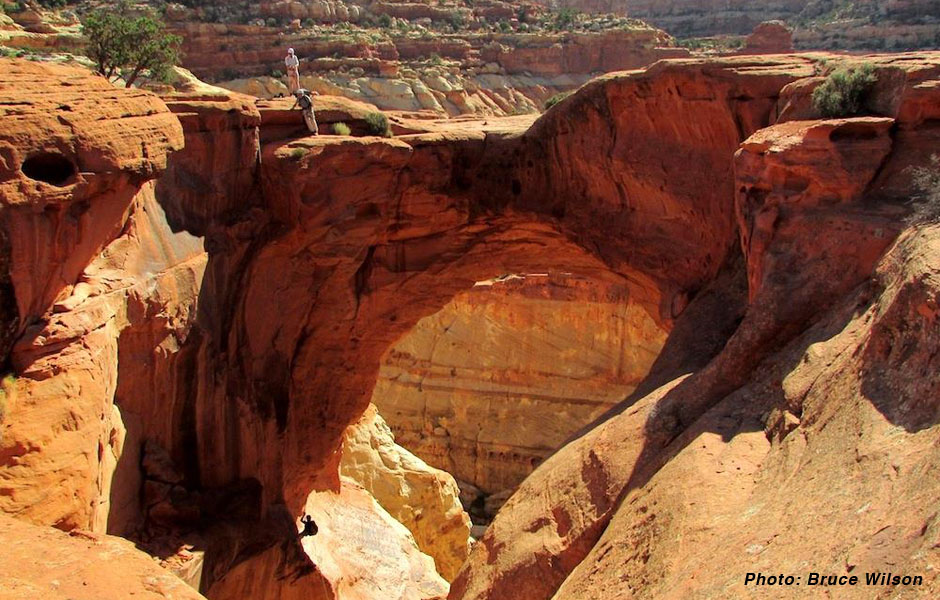
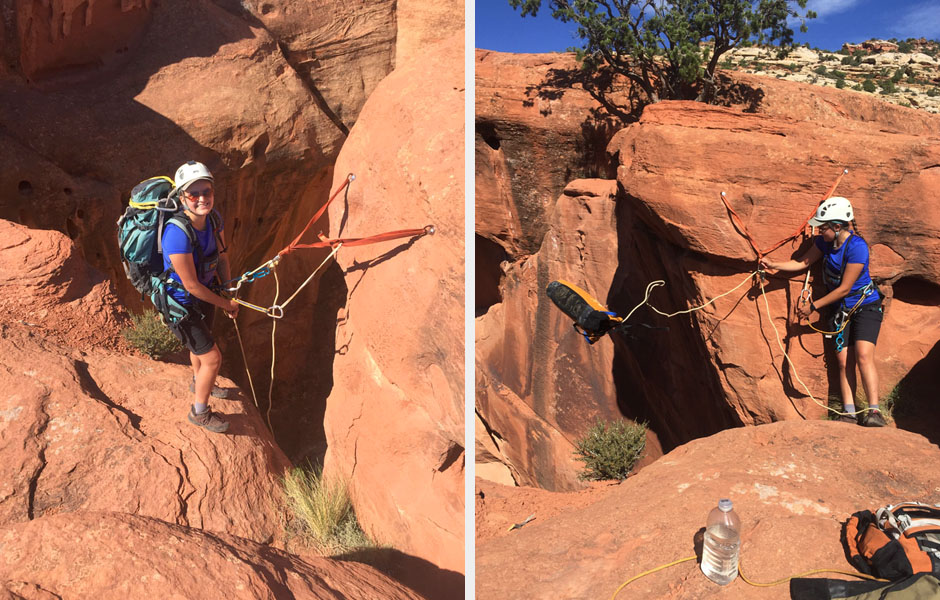
![]()
Cassidy Arch Canyon • Anchor Evaluation • June 6, 2016
Background
Cassidy Arch Canyon is located in Capitol Reef National Park, near Torrey, Utah. The Canyon was first brought to the general (Internet) canyoneering public’s attention in 2007, and has been recognized as a high-quality rappel-oriented canyon with a short approach and a high fun factor. Many of the groups going through the canyon are of limited experience and expertise. Cassidy Arch Canyon is the most popular canyon in CRNP.
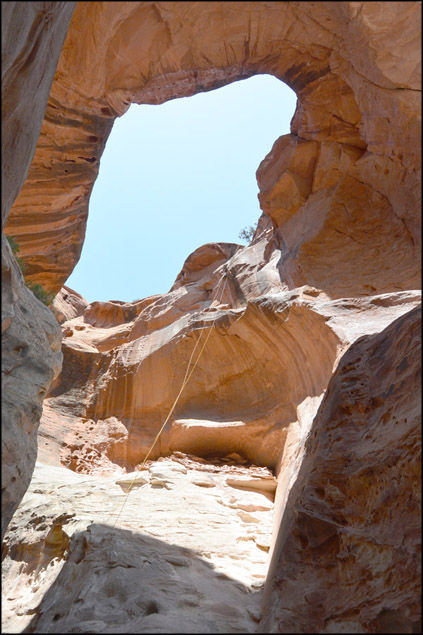
Cassidy Arch is a dramatic Wingate Sandstone arch at the top of the escarpment above the western end of Grand Wash accessed by a constructed trail off the scenic drive not far south of the Visitor Center. A moderate trail climbs 400 feet in about a mile to the top of the arch and a spectacular view of the rugged lands to the southwest. The trail is popular with hiking visitors to the Park.
The canyoneering route starts with a dramatic 150-foot rappel through the hole behind the arch. There is one small pinon pine located on a small ledge right at the edge of the hole that is used as the anchor. Canyoneers have been encouraged to use a retrievable anchor off this tree, so they do not leave a visible sling and ring that the hiking visitors would notice. Many people consider anchor slings left by canyoneers to be unsightly litter and/or an attractive nuisance, and the general ethic in canyoneering is to not leave anchor webbing where it is visible to hiking visitors. With the increase in traffic, slings have been left on the tree on a regular basis, though often removed by the next group.
Canyoneers in general prefer to descend canyons using natural objects for anchors, rather than using drilled construction bolts. Bolts are usually reserved for locations where no practical natural anchor can be found, and in canyons with a lot of traffic, where bolts can be used to minimize traffic damage to the natural environment. When Cassidy Arch Canyon was brought to the public’s attention in 2007, there were bolt-anchors in place for three of the seven rappels. The second rappel in particular has an unusual geometry that does not provide much opportunity to utilize a natural anchor, plus doing so would likely leave a fair bit of webbing that would be visible to hiking visitors from the Arch. The bolted anchor is well situated both for easy access and a clean line of rappel, and is in a place that is not visible from the Arch and adjacent areas.
Visitation
Cassidy Arch Canyon has seen a significant increase in visitors in the last two years. The Park does not formally track visitation to any technical canyons. The safety and longevity of the small tree traditionally used to anchor the first rappel has been brought into question due to the increase in visitation. With Park authorization, a local canyoneer recently installed a two-bolt anchor for the first rappel, but visitors have commented that it too difficult to reach. The Park reached out to the Coalition of American Canyoneers to assess the anchor situation, and propose another solution, if possible.
Site Visit
On June 6th 2016, we met with Chief Ranger Scott Brown to discuss the situation. Dean Brooks is an active canyoneer and a VIP (Volunteer In Park) helping with backcountry patrol. He brought along his neighbor Rick Larsen, and Tom Jones as an expert canyoneering anchor person, familiar with both natural and bolt-based anchors. The objectives of the Park in this matter are to:
• Provide for visitor safety, within the expectations of reasonably equipped and experienced technical canyoneering visitors;
• Protect the resource, including preserving vegetation, minimally altering the rock, and minimizing any visual impact on the hiking visitor; and
• Preserve the original flavor of the canyoneering route.
It was also noted that if the anchor was moved from the tree, canyoneering visitors would need to be informed of this change for at least a year, until this change was absorbed into the canyoneering community; and that such communication would, first of all, have to WORK, and second of all, have to be minimally intrusive.
We were joined by lead canyoneering Ranger Josh Olson for a brief final talk with Chief Ranger Brown, then Josh, Dean, Rick and Tom made a visit to the site. After a rather warm hike up, we examined the site for possible lines of rappel and anchors.
Site Notes – First Rappel anchor at Cassidy Arch
The Park does not place anchors itself, but can authorize citizens to do so. Placing bolts without authorization is not legal. Canyoneers descend the canyon with an understanding that it is their duty to determine the safety of the anchors, and not the duty of the Park nor of other citizens to provide safe anchors.
First to note is that the tree, though small, is still strong and healthy, though also showing signs of considerable wear from visitor contact. The lower trunk and branches are polished from use. Using the tree as an anchor, to start the rappel, the individual must push past the tree to get to the edge. A limb had been broken off the tree recently and was lying adjacent, with needles still green and intact.
The recently installed bolts are behind the tree, past the normal rap start point. They are well installed in solid rock. To reach them, experienced canyoneers would establish a safety sling on the tree (to guard against a fall), then step around the tree and reach out over the edge to rig the rope. It would then be somewhat problematic to assist others to the rap start point, and get them on rappel. It seems these bolts are placed a bit too far for most canyoneers to comfortably reach, and a couple of groups have gone through, noted the bolts, but used the tree anyway, considering it safer and more convenient.
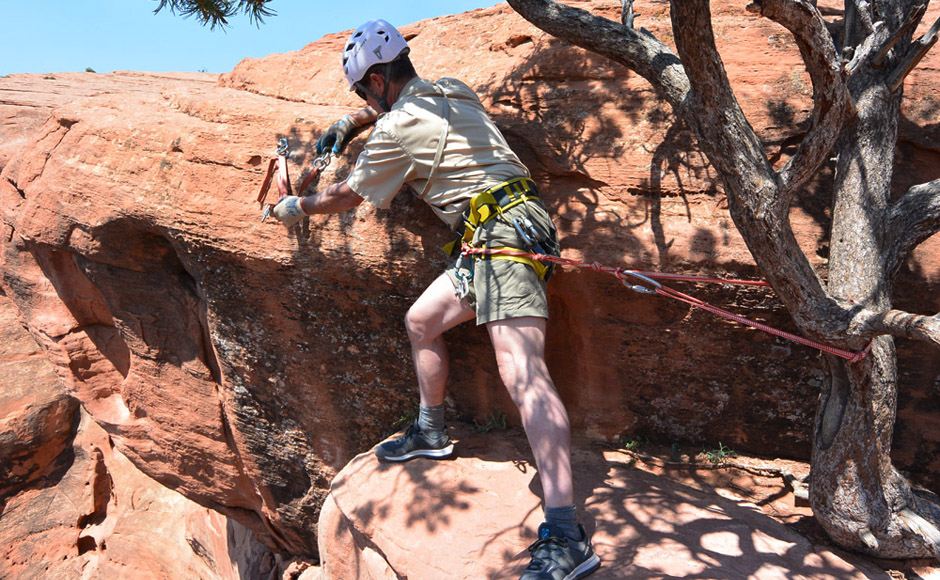
A. We examined the area between the tree and the new two-bolt anchor, and it would be possible to move the anchor to a new location, about half way between the bolts and the tree. This anchor could be rigged from the front side of the tree, and would be easier to initiate the rappel, though it would still require stepping around the tree to get started. An additional complication is that at the most straightforward place to put new bolts, the rock is hollow, so the bolts would have to be put a foot or so higher – not a significant problem but one the bolt installer would need to be aware of. To an experienced installer, this would be an easily found and solved problem.
B. We examined a ledge and wall about 8 feet from the tree ledge. This location offers a smooth wall of robust rock and a clean line of rappel, with easy access to the anchor and an easy start to the rappel. The location would not be seen by hiking visitors from above and behind the arch, the most popular viewing location. An anchor here would be visible to visitors that walk onto the arch but would be far enough away from them to not be “in their face”. If the anchor was painted to color-match the rock, many visitors would not notice it.
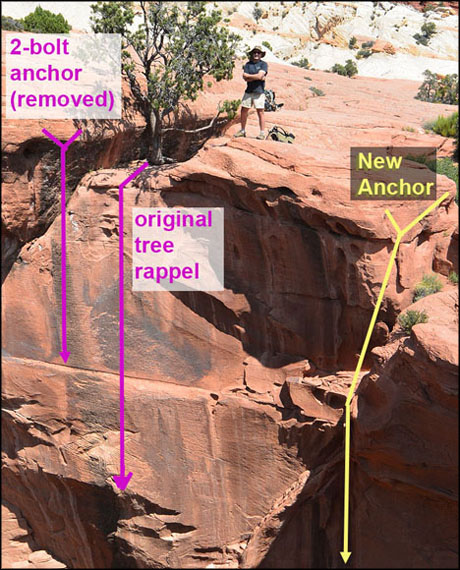 We examined a possible rappel point on the western side of the hole, and back a ways. While this location has a comfortable line of rappel, it does not provide for a clean pull, and use of it would result in considerable rope grooves. It would also be a less-dramatic rappel.
We examined a possible rappel point on the western side of the hole, and back a ways. While this location has a comfortable line of rappel, it does not provide for a clean pull, and use of it would result in considerable rope grooves. It would also be a less-dramatic rappel.
Other places around the rim of the hole do not provide any reasonable alternatives. In most places, there are no features to work with – the rock mostly forms a 90-degree edge. Any anchor places other than A) or B) would be atop the rim and conspicuous to all visitors, plus would have an awkward, inconvenient and possibly dangerous rappel start.
Recommendation
Our recommendation is to place a two-bolt anchor at position B and remove the existing bolts from behind the tree. A de-galvanized chain should be used to rig the anchor, and the chain, bolt heads and hangers painted to match the rock color.
While a new anchor could be placed behind the tree, continued visitor contact with the tree would kill it in the one to three year time frame.
No other location was noted as being practical.
The new anchor location would need to be communicated to canyoneering visitors. An inconspicuous weatherproof note on or at the base of the tree would probably be sufficient as an on-site notification. The Coalition of American Canyoneers can take care of notifying route-description providers and encouraging them to update their information.
Site Notes and Recommendations – Further down the canyon
We rappelled off the new bolts and continued down the canyon. Increased signs of passage were noted since my previous visit, perhaps two years prior. In particular, there are three rappels that are not set up well for the level of traffic the canyon now sees.
Rappel #3 is anchored from a small tree and descends two drops. The tree shows signs of stress and is likely to be killed and/or unsuitable for use as an anchor in the one to three year time frame. We recommend that a two-bolt anchor be installed at this location to preserve the tree.
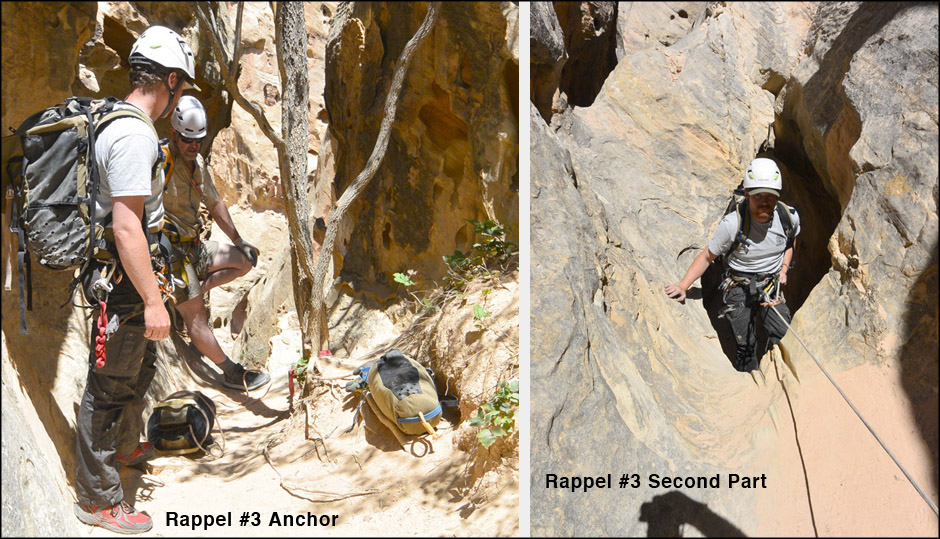
The second stage of Rappel #3 is developing serious rope grooves. While these grooves are not likely to be seen by any visitors other than canyoneers, they will get deeper with further use, and some people will get their ropes stuck here. We recommend adding a two-bolt anchor for the second stage of Rappel #3.
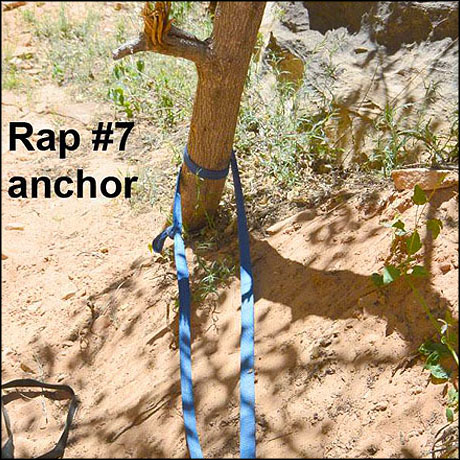
Rappel #7, the last rappel in the canyon, is anchored from a small tree. The tree shows signs of stress and is likely to be killed and/or unsuitable for use as an anchor in the one to three year time frame. We recommend that a two-bolt anchor be installed at this location to preserve the tree.
Thank you for your consideration.
Tom Jones
![]()
The complete report is available to download:
Cassidy Arch Canyon • Anchor Report We regularly deal with land managers, national park officials, and politicians. The broader our membership base the greater our impact.
